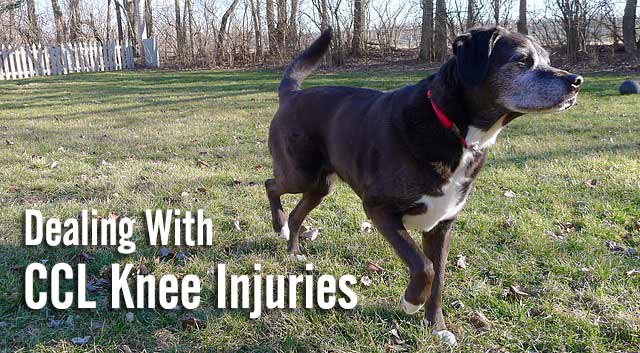 Unfortunately, what I’ve been worrying about for years has happened. Haley recently ruptured her CCL. If you don’t know what the CCL is, it’s the cranial cruciate ligament, equivalent to the ACL in our human knees. Her knee problems started about three years ago when she stretched the ligament. Even though it tightened up after a few weeks of limited activity, it’s given her trouble on and off since then and arthritis added insult to injury, so to speak.
Unfortunately, what I’ve been worrying about for years has happened. Haley recently ruptured her CCL. If you don’t know what the CCL is, it’s the cranial cruciate ligament, equivalent to the ACL in our human knees. Her knee problems started about three years ago when she stretched the ligament. Even though it tightened up after a few weeks of limited activity, it’s given her trouble on and off since then and arthritis added insult to injury, so to speak.
All of the things I’ve done to try to protect Haley’s knee, like starting her on Adequan injections, were outmatched by a few meandering deer passing through our backyard. She set off to protect her territory on four legs but returned from the chase hobbling on just three. After giving her several days to see if her condition improved, she would only put a little weight on the leg while walking and she would hop along on three legs when she wanted to move faster. I had a bad feeling about her condition and our vet confirmed my suspicion; she had ruptured her CCL and needed surgery. Ugh!
The first part of this video shows how Haley was getting around before her surgery.
Why Are CCL Knee Injuries So Common?
CCL injuries are one of the most common orthopedic injuries in dogs. I’ve known several family members and friends whose dogs required CCL surgery and one of Haley’s littermates has the exact same knee injury.Some dogs injure the ligament while running when they quickly change directions. The shift in their body direction at high speed puts a great deal of weight and stress on the knee, especially if a dog is overweight or obese. Other dogs may have chronic degenerative ligament disease where the ligaments become weak with age and eventually stretch, tear or rupture.
Dogs at a higher risk of ligament problems are spayed females and larger breed dogs. A few studies have found a link between early spaying and neutering and an increased risk of CCL injuries related to the role that sex hormones play in bone growth and development. Another reason CCL injuries might be so common is the increased number of overweight and obese dogs these days.
Do Ruptured CCLs Always Require Surgery?
I’ve read a lot of articles about successful, non-surgical treatments for ruptured CCLs but most of those remedies work best for small dogs under 25 pounds with most treatments being coupled with a period of restricted physical activity. Some dog owners have had success with stifle braces or custom-made casts. Even though there’s a variety of therapeutic and holistic types of treatment, surgery is often the best option for larger dogs and it was the course of action recommended by Haley’s vet.Types of CCL Surgical Repairs
There are several types of surgical repairs for CCL knee injuries. Some require cutting the bone and using plates to stabilize the joint such as the Tibial Plateau Leveling Osteotomy (TPLO) or Tibial Tuberosity Advancement (TTA). Other surgeries are suture based where a heavy suture or wire is used to stabilize the joint which takes over the function of the ligament until scar tissue can form to help stabilize the knee. For more details on surgery options, check out this article by the American College of Veterinary Surgeons. It’s good to keep in mind, one of the most important factors affecting the outcome of the surgery is the experience level of the surgeon.Haley had the extra-capsular suture stabilization type of surgery a little over a week ago. The first 48 hours after surgery were a little rough, especially when it came time for her to do her business outside and none of us got much sleep around here. I saw a big improvement on the third and fourth day after surgery but then she had a side effect to Rimadyl (one of her pain medications) that forced us to discontinue its use, so she’s been in a little more pain while finishing out this first week. She’s such a trouper and an exceptionally tolerant patient, especially when I have to do her rehab flexion and extension exercises.
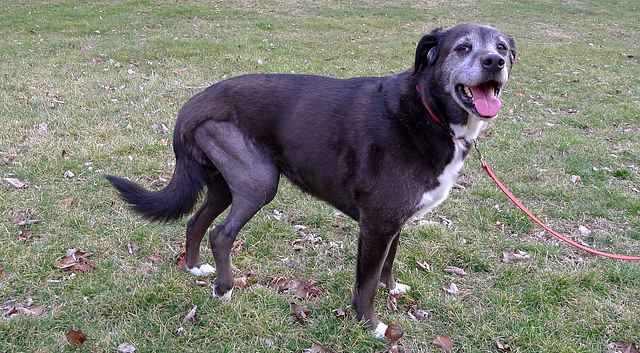
One week after Haley’s CCL surgery
Here are some tips I’ve discovered over the past week while helping Haley recover from her surgery.
10 Tips for Helping Your Dog After CCL Surgery
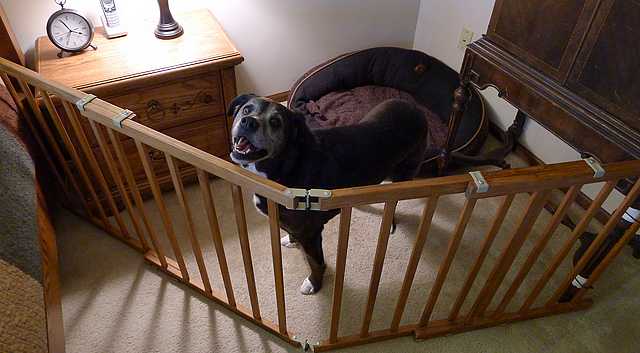
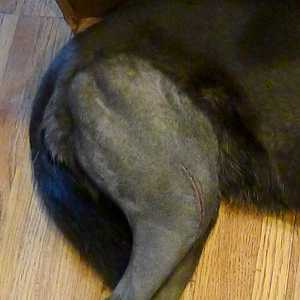
Haley’s CCL Incision
I hope the information and tips are helpful if your dog might be facing CCL surgery in the future. If you’ve already been through this, share your experience and any tips you might have. I’d love to hear them!
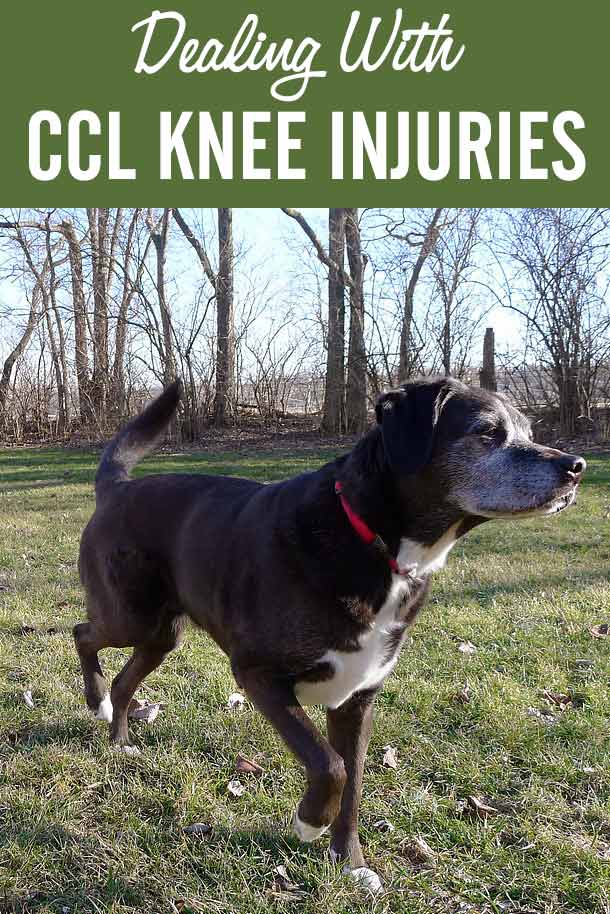

Oh no, I am so sorry to hear that Haley & you guys are having to go through this. Disconnecting the door bell is a very clever idea – I would’t have thought of it either – smart son!
We’ll be thinking about Miss Haley & are sending her healing thoughts. I hope the next 11 weeks will go by in a breeze.
Thanks so much, Barbara. ? Haley’s napping here beside me as I catch up on the blog. I wish I could meet up with you in Orlando, but I can’t wait to see all the healthy, organic products you discover there next week.
Yes, I was really looking forward to meeting you in Orlando! When my press credentials were approved, one of my first thoughts were “Cool, I’ll get to meet Elaine” 🙂 – Miss Haley will be glad to have you by her side though.
Haley, we are sending prayers for your recovery. Soon you will be better than ever!! So many good things to remember if you are going through a surgery with your pup. And remembering that the whining probably means they need something like a blanket or water. Such a good puppy Mommy!!
Aw, that’s so sweet of you to say that, Julie. We sure appreciate your good thoughts and prayers too. ?
That is a major bummer! So many dogs seem to have different knee injuries. Thankfully that hasn’t hit any of us yet and we want to keep it that way. Good luck for a speedy recovery.
Yes, I hope you and Bailey stay healthy and happy. This knee surgery stuff isn’t much fun.
So so sorry to hear about this. You’ve added a great list for people to take stock of – especially the doorbell. That would be disastrous in our house. Prayers for a speedy and uneventful recovery. Hoping to see you running around like new soon. All the best! PS: please keep us posted on Haley’s progress!
Thank you, Cathy! I was so glad Cody mentioned the doorbell too because the day after Haley had her surgery we had the delivery of the Girl Scout cookies we ordered and a box from Chewy.com
Oh poor, Haley! Hope her recovery is speedy and relatively pain free.
Thank you so much, we appreciate your good thoughts and wishes.
I’m so sorry you’re going through this. Wishes for a speedy recovery!!
This is an incredibly helpful post. I’ve seen a number of people whose dogs have experienced this. Now I have a place to direct them!
Maggie, thanks so much for your well wishes. I hate that so many dogs have this issue, but I guess we humans are the same way, lots of knee problems out there.
Ouch! I hate the thought of that lovely graying face in pain like that! Best wishes for a speedy recovery Haley!
Thank you for the advice. I can imagine my Hershey (an early spayed, large female) suffering just such an injury. I’ll try to keep her from harm, and keep your tips in mind if it happens anyway!
I’m sending you good thoughts that Hershey stays healthy and happy! ?
Haley was spayed young too, around 5 months of age. The studies are really interesting because they show the growth plates in longer bones close around one year of age, but when a dog is spayed or neutered before one year of age, the growth plates take longer to close and the dog’s legs grow longer than they should which places more stress on the knee joint. There seem to be many reasons now to reconsider early spaying and neutering.
What a great tip from Cody! I can’t imagine holding Kilo back when the postman or someone comes to the door while he is recovering.
Wishing Haley a fast recovery, poor baby.
Yeah, that’s one of my biggest fears now. I’m so worried she might overdo it once she starts feeling better. Maybe I should put a sign on the door not to knock either, haha.
Poor Haley! We are glad to see she is recuperating though! I’ve pulled my knee ligament before too and mom was holding her breath that it got better. I have a good pal that had to have both of her back knees done and she is as good as new now. Thanks for the great tips, hopefully mom won’t need them! Love Dolly
I hope Mom won’t need those tips too, Dolly. ? Thanks for the encouraging words about the pup that had both knees done. Our vet mentioned a Boxer dog that he performed the surgery for both knees at the same time and the dog is back to competing in agility again now. I hope Haley has great results with her outcome too.
Ah, I’m sorry to hear about this! I worked for a bit for a veterinary specialist, and I saw a lot of these knee cases come in and head out again. I know it’s common. My only tip, based on that experience, is to follow your surgeon’s confinement schedule to the letter. Once she starts to feel a little better, she’ll want to get back up to her old antics. And doing so might cause her to hurt her knee again. Use sedatives if you must, but do keep her calm for that full rest period.
Best of luck!
Jean from Welcome to the Menagerie
Thanks so much for that valuable piece of advice, Jean. Our vet mentioned that too and it would be horrible to have to go through all of this again after she would be so close to making a full recovery.
We usually let our pups dictate what they can do because we think they know best about how they feel, but this is one time that I’ll be taking over to make sure she doesn’t overdo it before her knee’s completely healed. Thanks for the great reminder!
Ouch! Poor girl. :/ Hope she feels better soon!
Thanks for the positive thoughts! We really appreciate it. ?
I hope Haley is on the mend. Thank you for such an informative post. There is so much to think about. Really it is as difficult as taking care of a sick baby. Actually, that is what you are dealing with here. You have to figure out what they want, keep them safe, stop them from hurting themselves.
Thank for sharing, and much love and hugs to Haley for a speedy recovery.
Thanks for the love, hugs and kind words, Suzanne. Haley’s had a extra rough time because of her stomach issues and you’re so right about it being like taking care of a sick child. I was having flashbacks of when my sons were babies and those long nights when they were crying because they were sick or teething. It makes you feel so helpless when you can’t comfort them right away but there’s such a feeling of relief when they finally are able to relax and rest for a while.
We’ve never had to deal with that in any of our dogs – hopefully we won’t have to, but this is lots of good info. (Of course, we did have to deal with an amputation for our last pup – a whole other kettle of fish….) Hailey looks so cute behind the baby gate. I hope she has a quick recovery!
Thanks, Jackie. ? I’ve never had to deal with an amputation but from what some of our fellow bloggers have written about, that’s a pretty difficult experience. Our dogs are wonderful role models for the incredible strength and attitude they have when facing painful or challenging events. They seem to handle it so much better than we humans.
I am so sorry that Haley had to have surgery. I hope that she heals quickly. Basset Hounds are more prone to back injuries so we are very careful not to let him do much jumping and he isn’t allowed on our bed. Dogs will be dogs though and sometimes no matter how hard you try to prevent it, they injure themselves.
I’m knocking on wood that Bentley stays healthy and happy with no back problems. It’s really hard sometimes to protect our pups from themselves, lol!
So nice to meet you. I hope Haley feels better soon — I used Adequan with my older dog and it worked very well so hopefully that will provide comfort. Thanks for sharing your story.
Hi Christy! I’m glad you had great success with Adequan too. I’m hoping it will help protect Haley’s other knee too since they say about 40% of dogs that have CCL surgery end up having problems with the other knee too.
Thanks for stopping by today! ?
Hi there, this is a VERY well written article on recovering from CCL surgery! Thank you for stopping by or a never would have found it! Chloe has had on and off problems with her knees since she was quite young….she is now 12. We decided against the surgery as Metacam and rest really helped her! Of course, she only weighs 20 lbs. so it is quite different from a larger dog. My Newf mix has issues with his hind legs as he aged, but we did the best we could with him. I had rescued him from the ASPCA so really wasn’t sure what issues he had. I still miss him every day. So sorry that Haley has had to go through this…it is quite a long recovery. Your son sure is smart…I NEVER would have remembered about the doorbell!! Sending lots of POTP for a full recovery for Haley!
I’m so glad the Metacam and rest worked well for Chloe. It sounds like she’s doing great at 12 years old. While researching all of the alternative treatments to surgery, I came across so many conflicting articles about whether or not to go ahead with it. I wish larger dogs had more options and better success with non-surgical types of treatment but I’m thrilled so many little dogs like Chloe find relief from those painful knee problems.
Thanks for stopping by today and thank you so much for your kind words and get-well wishes for Haley. ?
Oh, it makes me so sad that Haley was hurt and had to go through surgery but I’m so glad it sounds like she is recovering well. Wishing her and you the best during the rehab stage.
She is so stoic in the video when she’s hobbling on three legs before her surgery, and after it too. She must’ve been in pain but she just looks happy and wags her tail anyway. Dogs!
Thanks so much for the good thoughts and wishes, Lindsay. She’s had a rough few days with a stomach infection, but we’re getting back on track with the rehab now. ?
Oh Elaine, I’m so sorry to hear about Haley’s injury! 🙁 We saw quite a few cruciate ligament tears in our practice, and I remember how incredibly important the post-surgical recovery period is. Fortunately, we saw great success with the surgery. I love your baby-gate idea, since it’s sometimes hard for larger dogs to have to be crate-rested for such long periods of time…having a makeshift pen makes it much easier for them to stretch their legs. Will Haley also be having traditional physical therapy as she heals?
This is such an excellent post with a very helpful blueprint for dog parents to follow during post-op cruciate repair. Hang in there, in a few weeks it will all be worth it! Sending healing thoughts and prayers Haley’s way!! 🙂
Thanks, Camille! I have to say that today is the first day that I feel we’re making good progress with the rehab. She was doing great on the third and fourth days and then she started having some stomach issues (colitis and related infection) that set her back a little bit.
Today is Day 12 after surgery and she’s finally putting some weight on her foot again. We have a rehab schedule we’re working on ourselves, but we’re probably going to do some hydrotherapy and cold laser treatments to help her along.
Thanks so much for your healing thoughts! ?
Aww, poor girl. That must have been so painful for her. I hate seeing my pets in pain, especially when I don’t know what it is. Luckily, Haley’s injury was diagnosed, and all is well now. It must have been traumatic for her. All the best to you!.
Thanks, Jeanne! Haley’s finally making good strides with the rehab so we’re seeing progress every day. ?
I’m SO sorry to hear about this. As you know we’ve been struggling with a similar issue at our house.
We use almost all these same things as you did to help Sampson, what I (hopefully) can add is about traction. I picked up rubber backed throw rugs to put on the floors that didn’t have rugs. if you can’t find decent rubber-backed rugs, you can use regular throw rugs but put a rug non-slip mat under it. They are pretty inexpensive if you have a Christmas Tree Shop or an Ocean State Job Lot near by.
If you have any questions or just want someone you can whine too (I know emotionally, physically and financially exhausting this can be) please feel free.
Meanwhile, I’ll be adding you all to my prayer list.
HUGS
Thanks so much, Jodi. ? I’ve been thinking about you and Sampson too. I know it’s been rough with this tooth and now the CCL injury. I hope they are both on the mend very soon. Haley had a bad case of colitis right after her surgery and we thought her slow recovery and attitude was all knee pain at first, but we got that taken care of and things are looking up around here.
I’m sending you and Sampson good thoughts and prayers too! ?
Ugh, it’s so awful when they are dealing with more than one issue. I’m glad you got Haley on the mend though, and glad those throw rugs worked out for you.
Thank you for your good thoughts on Sampson, he’s had a little set back with the knee, and it’s slow going, but I’m hoping we get there!
Oh no, I’m so sorry to hear about Sampson’s setback. The rehab for these surgeries are slow going anyway, so I bet Sampson will come right along and begin making good progress. Our dogs are so sweet and so tolerant of everything they have to go through. ?
Sorry Haley had a tear and surgery. Glad she is doing good. This was a great article. I’m going to pass it on to my friend who is having done on his dog in a few weeks. My dog Norman had the TPLO back in 2004 and never had a problem again with that leg with many years of hunting after that. Good luck with the rest of the recovery.
It’s wonderful to hear that Norman had such great success after his surgery and then no problems after that. I always enjoy the Nothing But Norman posts. It sounds like he was an amazing dog and hunting companion.
Thanks for passing the article along and I hope your friend’s dog does well with the surgery too. ?
Thank you so much for all the valuable information on CCL tears, surgery options, post-op care, as well as, your Adequan experience. Last year my 8 year old Lab mix, Layla, underwent TPLO on her right leg. It was an exhausting and heart breaking experience. However, it has been 10 months and she is doing well, but it has been a long road. We are hoping to keep her other knee healthy and have her on joint supplements. Her sister, Lily, now age 9, 75lbs, suffers from degenerative joint disease in both her elbows and with lots of care and restrictions has been doing well. She is on Cosequan DS, Rimydal 35mg daily, and Tramadol as needed. I want to add Adequan to her regiment in hopes of reducing pain and helping with mobility. Is Haley still doing well with Adequan? And what is her current dosage? Unfortunately, a couple of weeks ago Lily ran after something the woods and came out limping. She now seems to be having trouble with both of her hind legs and I fear she may have partial tears in both knees. She has an appointment with her primary vet on Friday, so we will know more then. I fear TPLO surgery will be to invasive for her, especially with both legs, as well as DJD in both elbows. Can you please tell me why you decided to do extra-capsular suture stabilization rather than TPLO? I’ve read that larger does do not do as well with extra-capsular suture stabilization, but I think it might be the best route for Lily if she does have a tear or tears. Do you know anything about the Tight Rope method? Thanks for listening, as well as, any information you can give me!
I’m so sorry to hear about Lily’s injury, Renee. It’s heartbreaking when an injury happens, especially when they have other issues that make it even more painful or difficult to get around. I’m glad Layla is doing well after her surgery though. I’ve heard the recovery from TPLO can be challenging. I’m always a little worried about Haley’s other knee too. I cringed a lot during those early days after surgery when she was putting a lot of stress on it.
Haley’s vet decided on the extra-capsular suture because he’s had great success with that method and she weighs about 50 pounds. I researched all the methods (including the Tight Rope) before Haley’s surgery and the conflicting opinions made it pretty confusing. My decision ultimately came down to trusting my vet, who’s performed many knee surgeries and has a good reputation. I think an experienced and competent surgeon is something some people might overlook, but it’s really the key to determining the right type of surgery and getting a successful overcome.
For the Adequan, we give Haley a 1mL shot once a month and I’m still thrilled with how well it’s working for her. I would think it might be really helpful for Lily too. The nice thing about Adequan is, you’ll know after about a month if it’s going to work for her, unlike supplements that are sometimes hard to judge their effectiveness. I would definitely try it if your vet approves.
I’m really hoping Lily hasn’t torn both CCLs. One thing that might help during her recovery is a custom leg brace for one leg while the other one might be recovering from surgery. I hope the appointment goes well tomorrow and I would love to hear back on what you find out and how she’s doing. I’ll be sending good thoughts and prayers your way. ?
Thanks for the informative article! It helped me make the decision to proceed with the surgery. I have a 21 pound Cavalier King Charles Spaniel with a torn CLL and when the surgery was done they also found a torn meniscus. Her recovery has been very long and she is still limping pretty pronounced even though it’s been over a month. How is Haley doing now?